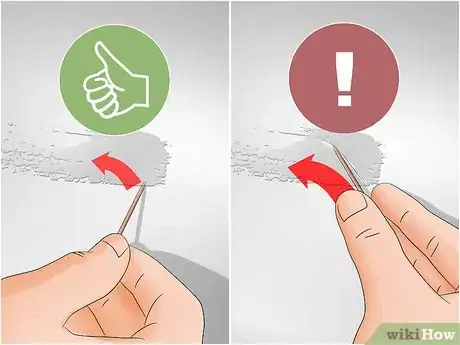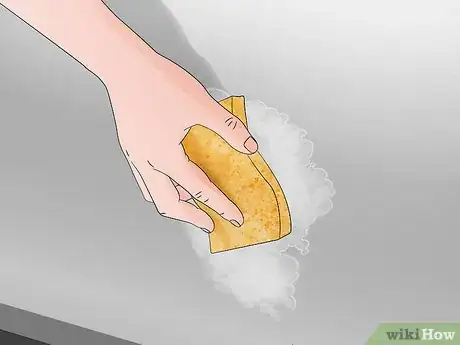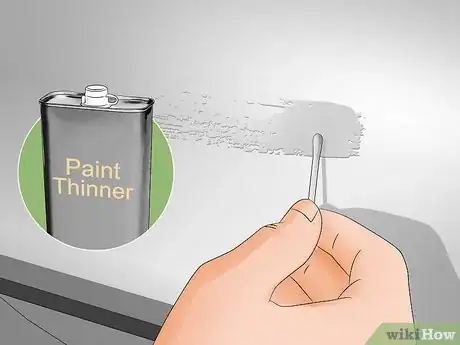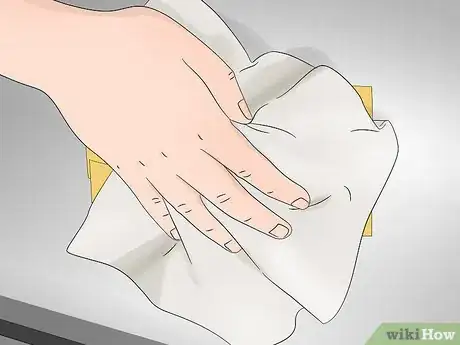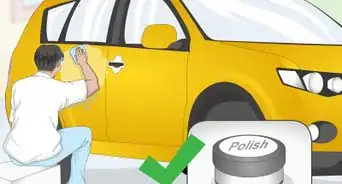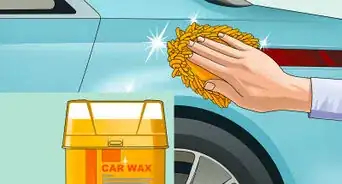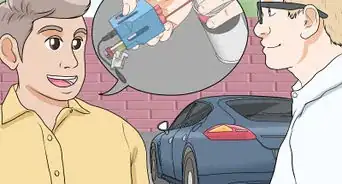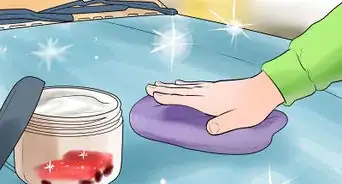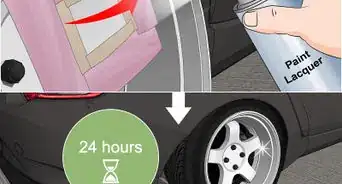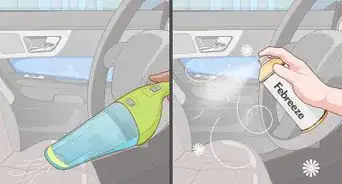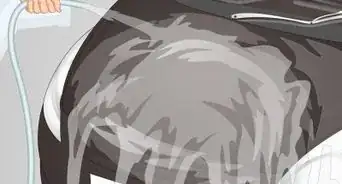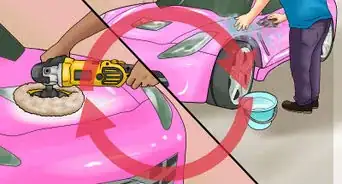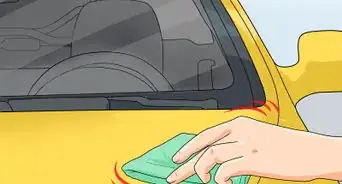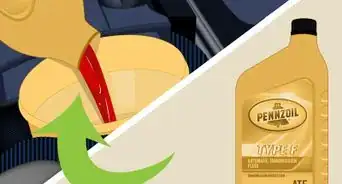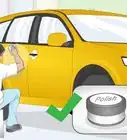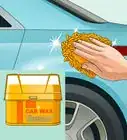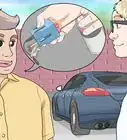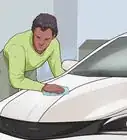This article was co-authored by wikiHow Staff. Our trained team of editors and researchers validate articles for accuracy and comprehensiveness. wikiHow's Content Management Team carefully monitors the work from our editorial staff to ensure that each article is backed by trusted research and meets our high quality standards.
This article has been viewed 190,933 times.
Learn more...
Removing unsightly paint from you car's exterior is a straightforward DIY project that immediately enhances your car's appearance. Paint on cars becomes chipped and nicked naturally after years of being driven, and it's often people's go-to method to just touch-up the paint themselves. These attempts at fixing a car's paint often don't completely cover up the original problem. Luckily, though, you can easily remove this touch-up paint by chipping at it or dissolving it with a thinning solution. Doing so makes the most of your car's appearance, whether you're trying to sell it or just wanting to restore the vehicle to its former glory!
Steps
Picking Away Loose Touch-Up Paint
-
1Scrape the car touch-up paint gently with your fingernail. This will evaluate if you can remove some or most of it. Touch-up paint that can be removed with a fingernail is generally not well applied, although it will make it that much easier to remove from the vehicle.[1]
-
2Pry the paint off using a toothpick. If the paint is loose on the car door but too firm to remove using only your fingernail, try to get it off with a toothpick. Slide the tip of the toothpick under one edge of the touch-up paint, and pry the paint upwards. Keep going until you’ve removed as much of the paint as possible.[2]
- If the touch-up paint is loose enough, or if it was applied recently, you may be able to remove all of it using a toothpick.
Advertisement -
3Apply only gentle pressure when scraping paint off. When using your fingernail or a toothpick to scrape touch-up paint from the car door, do not scrape it too hard. If you do, you might scrape off some of the car’s original paint and make the blemish worse.
- If the touch-up paint doesn’t come off easily with your fingernail or a toothpick, move on to more rigorous removal methods.
Using a Lacquer Thinner
-
1Wash the section of the vehicle with the dried touch-up paint. Squirt a mild dish detergent into a bucket, and fill the bucket with water from a hose or outdoor tap. Dip a rag into the bucket, and wash off the car door. Remove any dirt or grime covering the touch-up paint you’re planning to remove.[3]
- Always make sure the area with the dried car touch-up paint is clean before working on it. Otherwise you may rub grit and dust into sections of paint that you weren’t planning to remove.
-
2Dry the area thoroughly with a soft cloth or towel. Make sure that the towel or cloth you’re using is dry before you begin, otherwise it won’t fully dry the car door.
- If you’re not in a hurry, waiting 20 or 30 minutes at this point will allow the water to fully dry.
-
3Apply a lacquer thinner to the touch-up paint. Use a Q-tip to rub a small amount of solvent onto the dried touch-up paint to help soften it. Follow the instructions as printed on the prep solvent container, and leave the solvent on the car door for as long as the packaging suggests. Then, wipe the thinner off the car.[4]
- You can purchase lacquer thinner from your local automotive supply shop. Try prep solvent or mineral spirits if you cannot find a lacquer thinner.
Sanding Off Dried Touch-Up Paint
-
1Apply car masking tape to the area around the dried touch-up paint. Masking tape will allow you to avoid accidentally removing extra paint. Use the masking tape to box in the dried touch-up paint.[5]
- Car masking tape can be purchased at any local automotive supply store.
-
2Rub the dried touch-up paint gently with 150-grit sandpaper. 150-grit sandpaper is relatively coarse and will remove the softened touch-up paint. Press firmly when you’re sanding, and sand back and forth in short, even strokes. It’s OK if you scratch up all of the paint within the masking-tape box, but avoid scratching tape outside of the masking tape.[6]
- Remember that the lower the grit number, the more coarse the sandpaper. Sandpaper that is too coarse can damage your car, so avoid using anything coarser than 150.
-
3Brush away any paint dust or chips with a soft cloth or towel. After sanding, the section of car door you’ve been working on will be covered in a light coat of paint dust. Wipe this off and inspect the door to see if you’ve fully removed the touch-up paint.[7]
- If not all of the touch-up paint has been removed, sand the door again.
-
4Rub the area with 600-grit sandpaper. A fine-grit paper will smooth out any rough edges. While 600 grit is too fine to remove the touch-up paint, it will buff the area you’ve been sanding. As with the coarse sandpaper, sand back and forth using short, even strokes.[8]
- Make sure that you have both 150- and 600-grit sandpaper to remove the dried paint. The 150-grit paper will remove dried globs of paint, and 600-grit will smooth out the area after the dried paint is removed.
-
5Remove the tape and brush away any paint dust. Use a clean towel to clean off the car door and remove any lingering paint chips. The area is now ready for you to apply fresh touch-up paint.
- Throw away the tape once you’ve removed it from the car door.
Community Q&A
-
QuestionI used touch up paint on a car door. How do I smooth the paint?
 AndyazCommunity AnswerThis is a pretty delicate operation, but you could try using steps 7 and 8, starting with 320 grit wet or dry sandpaper and gradually working up to 1200 grit. Sand carefully. If you remove original paint, you could easily turn a slight blemish into a real eyesore.
AndyazCommunity AnswerThis is a pretty delicate operation, but you could try using steps 7 and 8, starting with 320 grit wet or dry sandpaper and gradually working up to 1200 grit. Sand carefully. If you remove original paint, you could easily turn a slight blemish into a real eyesore. -
QuestionIf I have a small bottle of car paint that is used for touch-ups, how do I reuse it if it has dried up?
 Community AnswerIf it is not totally dried out, then acetone will thin it enough to brush on again.
Community AnswerIf it is not totally dried out, then acetone will thin it enough to brush on again.
Things You’ll Need
- Dish detergent
- Bucket
- Soft rags or towels
- Prep solvent or mineral spirits
- Car masking tape
- 150- and 600-grit sandpaper
References
- ↑ https://www.yourmechanic.com/article/how-to-remove-lumps-of-paint-on-your-car-by-kevin-woo
- ↑ https://www.yourmechanic.com/article/how-to-remove-lumps-of-paint-on-your-car-by-kevin-woo
- ↑ https://www.yourmechanic.com/article/how-to-remove-lumps-of-paint-on-your-car-by-kevin-woo
- ↑ https://www.yourmechanic.com/article/how-to-remove-lumps-of-paint-on-your-car-by-kevin-woo
- ↑ https://www.yourmechanic.com/article/how-to-remove-lumps-of-paint-on-your-car-by-kevin-woo
- ↑ https://www.familyhandyman.com/automotive/diy-car-paint/car-paint-repair-touch-up-painting/view-all/
- ↑ https://www.familyhandyman.com/automotive/diy-car-paint/car-paint-repair-touch-up-painting/view-all/
- ↑ https://www.familyhandyman.com/automotive/diy-car-paint/car-paint-repair-touch-up-painting/view-all/
About This Article
To remove touch-up paint that’s dried on the car door, try picking it off with a toothpick. Just slide a toothpick under the edge of the paint and pull upwards to remove it. Don’t apply too much pressure, since doing so could remove some of the original paint on the door. If you can’t scrape the paint off, try using a lacquer thinner, which you can buy from an auto supply store. Another way you can remove paint is with sandpaper. Gently rub 150 grit sandpaper over the paint, and use 600 grit paper to remove any leftover rough edges. For tips on how to sand dried touch-up paint off your car door, read on!


